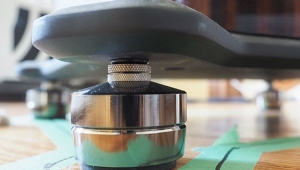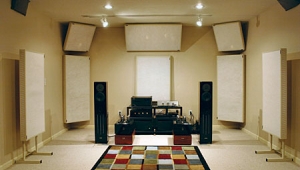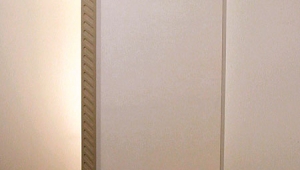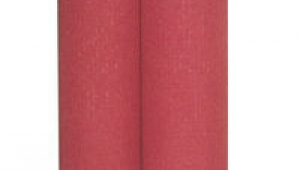| Columns Retired Columns & Blogs |
Echo Busters Decorative Room Treatments
One of the biggest challenges in setting up any new listening room is getting the room to work with your equipment rather than against it. I faced this challenge in spades when Trish and I moved into our dream house in the California hills. What would serve as my listening room was a wonderful, open space with panoramic views of the surrounding hills—a space that bore no resemblance at all to a traditional, rectangular, dedicated listening room. Instead, there was a wall of glass, a huge marble-and-glass fireplace, a 20' ceiling—and did I mention that it isn't actually a "room," but one arm of a continuous flowing space?
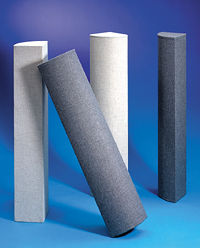 Back in Albuquerque, even in the dining-listening room of Trish's old house, I had had a fairly straightforward situation to deal with: roughly rectangular rooms, similarly constructed walls on all sides, and nice, thick carpets over floors of brick or concrete. But even in these benign environments, there had been challenges: first reflections from the sidewalls and ceilings, upper-bass boominess, etc. Still, nothing in my experience had prepared me for the challenge of making things work in our new home.
Back in Albuquerque, even in the dining-listening room of Trish's old house, I had had a fairly straightforward situation to deal with: roughly rectangular rooms, similarly constructed walls on all sides, and nice, thick carpets over floors of brick or concrete. But even in these benign environments, there had been challenges: first reflections from the sidewalls and ceilings, upper-bass boominess, etc. Still, nothing in my experience had prepared me for the challenge of making things work in our new home.
Echo Busters Decorative Room Treatments
I've used a lot of tools to tame and tune rooms over the years, from rugs, plants, and homebrew panel absorbers to such off-the-shelf products as RoomTunes, ASC Tube Traps, and RPG Diffusor panels. But for nearly a decade now, the mainstays of my approach have been Echo Busters, Double Busters, and Bass Busters, from Echo Busters of Deer Park, New York. This trio of (respectively) absorbers, diffusers, and bass traps has given me the flexibility to tune out a number of major problems and to optimize numerous speakers and listening setups.
Bass Buster
The Bass Buster is a 4'-tall quarter-round tower with a radius of 8". Under its fabric cover, it's a Helmholtz resonator—a rigid enclosed column with holes drilled and spaced to tune the BB for absorption at a particular frequency. In this case, the center frequency is 90-95Hz, but by adding foam to damp air movement inside the column, the absorption can be spread out over a broader range, from approximately 65Hz to 225Hz.
Back in Albuquerque, my room's combination of an 8' height, 17' width, and flexible drywall walls on two sides created a real problem in the 80-120Hz region. Regardless of where I placed my speakers, the upper-bass response was muddy and slow, the system's overall tonal balance too warm. The very low bass was okay, and by the lower midrange things had regained a bit of articulation, but the upper bass was a morass. Sound-pressure readings taken near the room corners with a RadioShack meter suggested that I had a boost of as much as 9dB at about 100Hz.
At the suggestion of Mr. Echo Buster, Michael Kochmann, I attacked the problem with Bass Busters, beginning with floor-to-ceiling columns in the room's four corners. Next, Kochmann suggested using a full cylinder of stacked Bass Busters—eight 4' quarter-rounds—centered behind the speakers at another point where my meter readings suggested that the upper-bass level was substantially elevated.
Voilà! With the Bass Busters in place, the bottom was cleaned up to a remarkable degree. My listening notes from that time detail how Nathan East's flying bass runs on Foreplay's "Bali Run," from Foreplay (CD, Warner Bros. 26656-2)—a bass reference disc then and now—remained clean and articulate as they traversed their range. Before, the notes would blur together sluggishly, with a "one-note" character as East ascended in pitch. In another listening session, I raved about how Ray Brown's bass lines on Soular Energy (LP, Concord/Bellaphon LELP 111), one of my all-time favorites and reference discs, regained their snap and bounce. Pitch definition was improved, and the image was much, much sharper and better defined.
The verdict? Problem solved. At $489/pair, my Bass Buster setup represents a few bucks, but the room had gone from essentially unlistenable to having excellent bottom-end balance and articulation. Money well spent.
Echo Buster
The Echo Buster absorber panel might well be the first Buster acoustic treatment that most people try, assuming that they're not attacking evils as pernicious as the bass boost I had in my Albuquerque room. One of the major factors in optimizing focus and detail resolution is ensuring that the direct sound from your speakers isn't muddied by reflected sound. The physics are pretty straightforward, but the bottom line is that you've either got to get your speakers away from reflective surfaces, or damp those surfaces so that reflected high-frequency information doesn't arrive at your ears soon enough to be confused what the speakers are trying to tell you directly.
The Echo Buster is a lightweight panel absorber: a foam-filled rectangular wooden frame that can be stand free or be hung on a wall. At about 5 lbs, it's easy to handle and move around, and can be located just about anywhere. Like most foam-based absorbers, the Echo Buster's absorption increases as frequency rises, going from essentially zero effect at 125Hz to being completely absorptive above about 750Hz.
Back in Albuquerque, I had no problems with sidewall reflections in my main listening room, but I did have a reflective floor and ceiling. I ended up with a pair of Echo Busters on the ceiling, at the first reflection point, and, during listening sessions, with four more flat on the floor, midway between the speakers and my listening chair.
The effects of damping first reflections weren't nearly as large as taming my upper-bass response, but they were certainly audible. Improved image focus was probably the biggest benefit, manifesting itself most obviously in an increase in the dimensionality and tangibility—the density—of images. My notes from one installation, a system built around Thiel CS2.3 loudspeakers, refer to Rickie Lee Jones' Naked Songs (CD, Reprise 45950-2). "RLJ's image is much sharper, much more dense. It finally seems like I could walk out and put my arms around her, instead of just knowing that she's somewhere over there."
Like the Bass Busters, the Echo Busters, once installed, became a fixture in my setups. Some speakers seemed to need a bit more floor and ceiling damping. With others, leaving the floor and ceiling a bit more reflective seemed to open up the soundstage and create a bit more space above the orchestra. But rarely, if ever, did I end up with a setup that didn't incorporate some damping above and below.
- Log in or register to post comments
